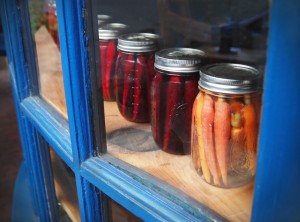While canning food is delicious and a great way to preserve excess food that you grow or purchase throughout the year, there are always some risks with home preparation. One of the biggest concerns of canners everywhere is botulism, a deadly bacteria that can grow on spoiled foods.
While there are several methods for identifying spoiled canned goods, a lot of times, it is readily apparent that something is not right. Regardless of why it happened, the most important thing is to ensure that the food is detoxified and disposed of properly. Botulism isn’t something to take lightly!
When you discover a spoiled canned good, then the UDSA has recommended that consumers avoid all contact with the possibly contaminated foods or liquids and suggests wearing heavy rubber or plastic gloves which should be disposed once the food is detoxified and the area cleaned.
Here is the proper procedure to properly detoxify the food and containers before disposal:
- Carefully place the suspect containers and lids on their sides in an 8-quart volume or larger stock pot, pan or boiling-water container
- Carefully add water to the pot until it completely covers the containers with a minimum of 1 inch above the containers. Be careful not to splash any water
- Place a lid on the pot and heat to boiling
- Boil for minimum of 30 minutes to ensure detoxifying the food and all contents
- Cool and discard the food, liquid, containers and their lids in a nearby landfill. To be on the safe side, do not attempt to salvage the canning jar, lid or rim.
Now that you’ve disposed of the actual food, it’s important to properly clean any tools, equipment, surfaces or anything that might have come in contact with the contaminated food and liquid. Here are some cleaning tips from the USDA article:
- Always wear rubber or heavy plastic gloves when there is a risk of botulism and dispose of them when you are done. Do not let anyone come in contact with the food or liquid.
- Clean all contaminated work surfaces and equipment with a fresh solution of 1 part unscented liquid household chlorine bleach to 5 parts water. Items to treat include work surfaces, equipment, can openers, clothing and any items that may have come in contact with contaminated foods.
- If any food leaked out, carefully wipe up with paper towels (wear disposable gloves!) and place them in a plastic bag before putting in the trash. Spray or wet contaminated surface with bleach solution and let stand for 30 minutes before wiping.
It’s always better to be safe than sorry! Remember that the best way to avoid any of these problems is to always follow trusted recipes to the letter, make sure you sanitize everything and check all of your jars before storing them to ensure a proper seal!


the reason we pressure can is that normal boiling won’t prevent botulism in non-acidic foods. So why is boiling the container for 30 minutes enough to kill an existing infestation?
Hi Miriam, thanks for commenting! From what I understand, boiling the container and contents doesn’t kill 100% of the botulism, which is why it is recommended to dispose of both the containers AND the contents. Boiling it, I believe, simply kills off some of the bacteria and helps make it slightly safer so it can be disposed without posing a health risk. As a side note, I think that preventing a bacteria from ever being there is a lot harder than killing one that’s already present.